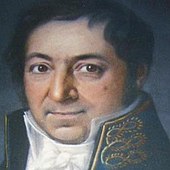Johann Bernhard Spatz
Johann Bernhard Spatz (born November 18, 1782 in Speyer ; † June 16, 1840 in Zweibrücken ) was a German civil engineer and architect in the service of the Kingdom of Bavaria .
Live and act
He was born as the son of the Lutheran pastor Friedrich Wilhelm Spatz and his wife Maria Margaretha Salome geb. from Stoekken. Her father, the Speyer town syndikus Johann Gerhard von Stoekken, was the great-nephew of the poet Christian von Stökken . On November 10, 1800, Johann Bernhard Spatz enrolled at the University of Heidelberg , in the subject of political economics.
As early as 1807, Spatz carried out surveying work for the road and bridge construction department in the Speyer district on behalf of the administration of the French department du Mont-Tonnerre , as a conductor . On June 15, 1810, he officially entered the service of the French government. Initially a 3rd class conductor, he was promoted to 2nd class in 1811 and 1st class in 1813.
After the return of the areas on the left bank of the Rhine to Germany, a joint Austrian-Bavarian government was established in Kreuznach from 1814 , to which Johann Bernhard Spatz successfully applied for a position as a construction manager in the Speyer district in October 1814 . He became a district engineer in Speyer and in this position was responsible for building waterways and bridges as well as planning, building and repairing all public buildings. On April 24, 1816, Spatz took over the office of district engineer from Alzey , but continued to work in the Speyer and Frankenthal districts .
On June 1, 1816, he entered the service of the Kingdom of Bavaria as a civil servant; on December 1, 1817, he was promoted to building inspector and head of the state building inspection in Speyer, which was responsible for the entire front and south Palatinate . In addition to the planning and construction of public buildings, Johann Bernhard Spatz took care of the expansion of the road network and was the inventor of the "Spatz road construction method" , which is why his biographer Lothar Keller called him in 1980 the "pioneer of modern road construction" in the Palatinate .
On March 7, 1836, Spatz was appointed district building officer of the Bavarian Rhine District, which meant that he was responsible for the management of all state construction in Bavaria on the left bank of the Rhine. In the second half of 1839 he fell seriously ill and had to travel to Switzerland for a longer convalescent leave . In June 1840, Johann Bernhard Spatz stayed at the Zweibrücken building inspection to check the accounts. On the evening of June 16, he suddenly felt unwell in the Heck inn and died in the presence of the innkeeper Ludwig Heck and the road attendant Johann Laurent. He was transferred to Speyer and buried in today's Old Cemetery , where his tombstone has been preserved. It says: "After many years of useful work he died as an honest man" .
Johann Bernhard Spatz was caught in the so-called " Weinbrennerstil ". He planned or built u. a. the Kurhaus Bad Dürkheim , the neighboring St. Ludwig Church in Dürkheim , the Protestant church in Gerolsheim (plan by August von Voit ), the Catholic Church of St. Cross and the like. St. Nikolaus in Hayna , the Catholic parish church St. Maria Magdalena in Roxheim , the prot. Church Ludwigshafen-Ruchheim (together with August von Voit), the building of today's Domhof-Brauerei Speyer (Große Himmelsgasse 6), the Johannes-Hoffmann-Schule in Mutterstadt , forester's house Kehrdichannicht and the forester's house Wolfsgrube near Elmstein . Until his transfer in 1830, Johann Philipp Mattlener was one of Spatz's closest employees. Both built in the same classical style.
Johann Bernhard Spatz was married to Charlotte Katharina geb. Holtzmann (1784–1825), daughter of the Mayor of Speyer, Carl Alexander Holtzmann . Their son Carl Alexander Spatz (1810-1856) was a member of the Frankfurt National Assembly in 1848/49 . The grandchildren include Karl Spatz (1845–1907), architect, builder and founding director of the Palatinate Trade Museum , Karl Bernhard Lehmann (1858–1940), pioneer of microbiology and industrial hygiene , Wilhelm Ludwig Lehmann (1861–1932), painter and university professor in Zurich and Julius Friedrich Lehmann (1864–1935), anti-Semitic - folk publisher in Munich .
Executed drafts (selection)
literature
- Lothar Keller: Johann Bernhard Spatz, Life and Work of an Engineer , in: Pfälzer Heimat , Speyer, born 1980, pp. 52–56
Web links
- Personal data page in the thesaurus portal
- Website of the Prot. Church Gerolsheim, with mention of Johann Bernhard Spatz
- Website for the cath. Hayna Church, with mention of Johann Bernhard Spatz
- Website for the cath. Parish church Roxheim, with mention of Johann Bernhard Spatz
- Website with photo of the forester's house Wolfsgrube
Individual evidence
- ↑ Data page on the father
- ^ Georg Feldmann: Communication on Johann Bernhard Spatz , in: Pfälzer Heimat , Speyer, born 1981, p. 79
- ^ Handbook of the Diocese of Speyer , Speyer, 1961, p. 131
- ↑ PDF document on Carl Alexander Spatz
- ↑ Rudolf H. Böttcher: The family ties of the Palatinate Revolution. Special issue of the Association for Palatinate-Rhenish Family Studies. Volume 14. Issue 6. Ludwigshafen am Rhein 1999. p. 261
- ↑ Melanie Lehmann: Publisher JF Lehmann - A life in the fight for Germany , FJ Lehmann Verlag, Munich, 1935, p. 7
| personal data | |
|---|---|
| SURNAME | Sparrow, Johann Bernhard |
| ALTERNATIVE NAMES | Sparrow, Bernhard |
| BRIEF DESCRIPTION | German architect and civil engineer |
| DATE OF BIRTH | November 18, 1782 |
| PLACE OF BIRTH | Speyer |
| DATE OF DEATH | June 16, 1840 |
| Place of death | Zweibrücken |













